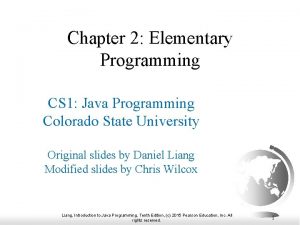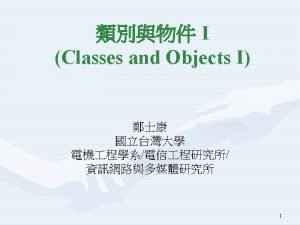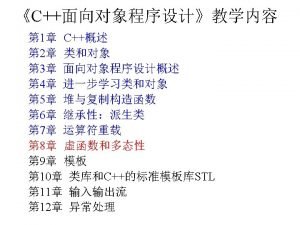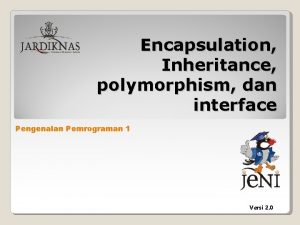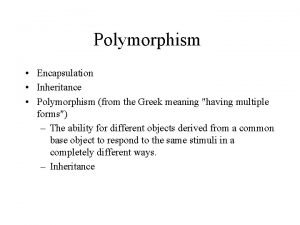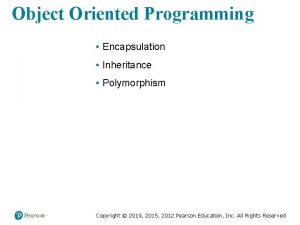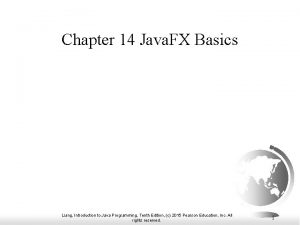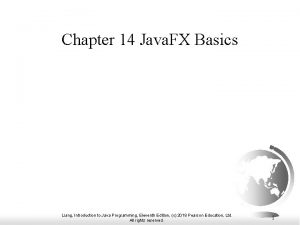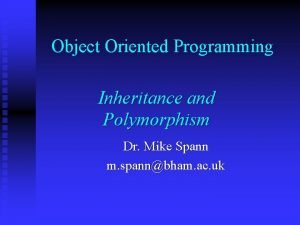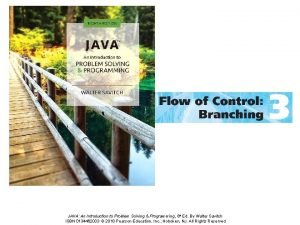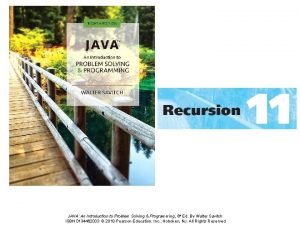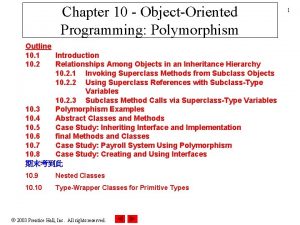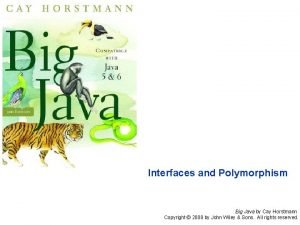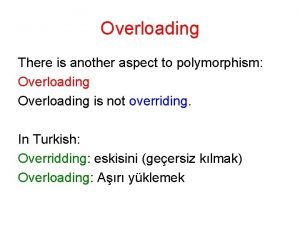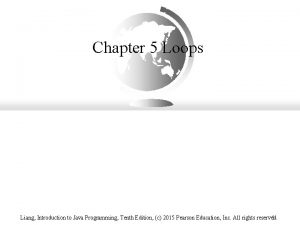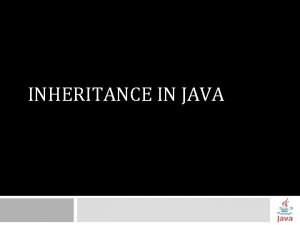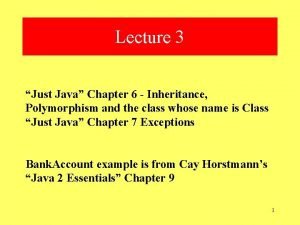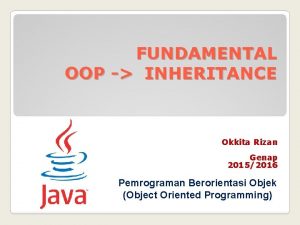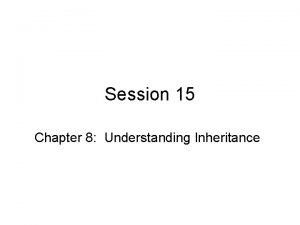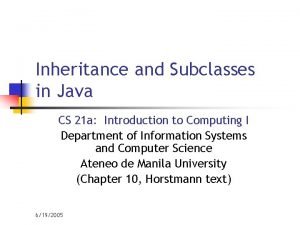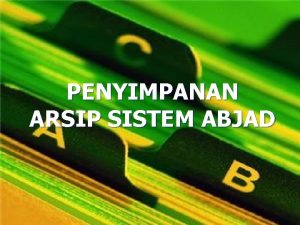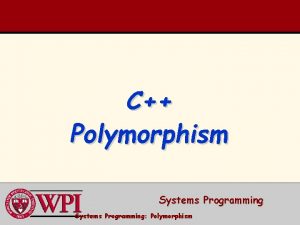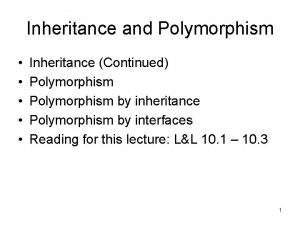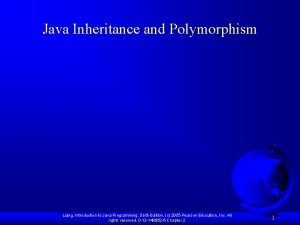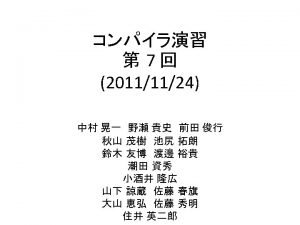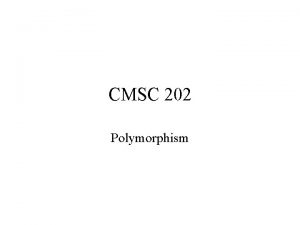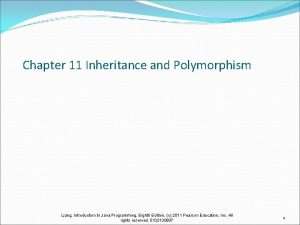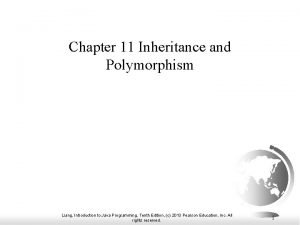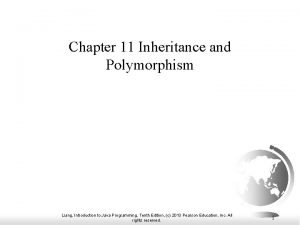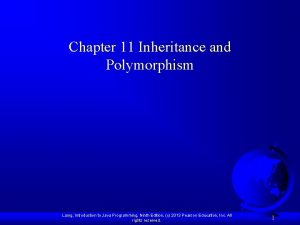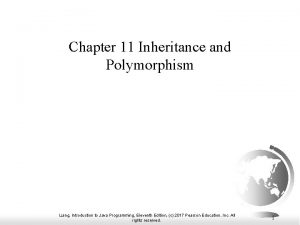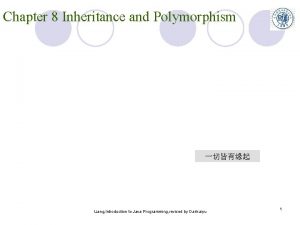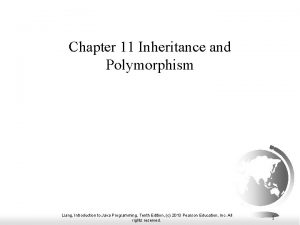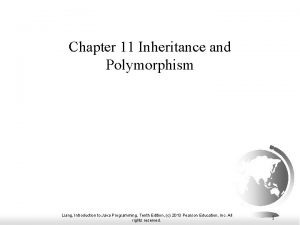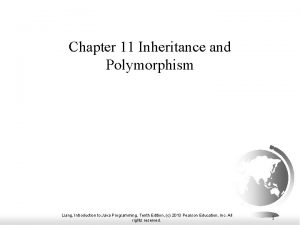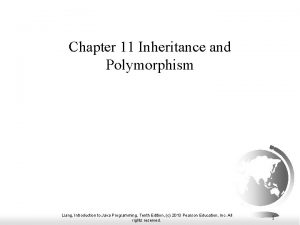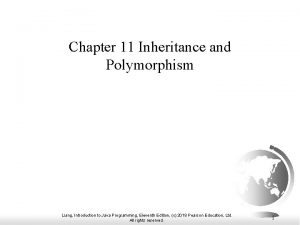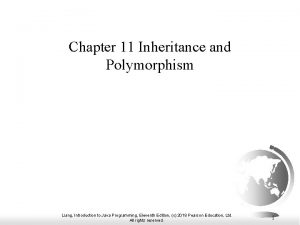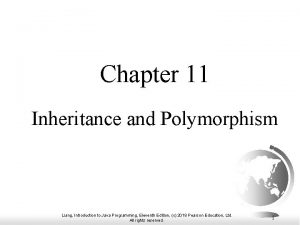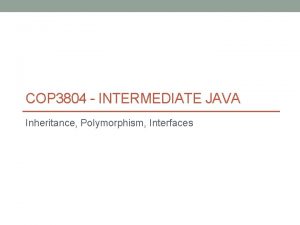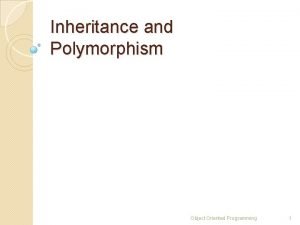Inheritance and Polymorphism Liang Introduction to Java Programming








![animation Trace Execution public class Faculty extends Employee { public static void main(String[] args) animation Trace Execution public class Faculty extends Employee { public static void main(String[] args)](https://slidetodoc.com/presentation_image_h2/5650cc3c763ece7159889ecf9802cc3e/image-9.jpg)
![animation Trace Execution public class Faculty extends Employee { public static void main(String[] args) animation Trace Execution public class Faculty extends Employee { public static void main(String[] args)](https://slidetodoc.com/presentation_image_h2/5650cc3c763ece7159889ecf9802cc3e/image-10.jpg)
![animation Trace Execution public class Faculty extends Employee { public static void main(String[] args) animation Trace Execution public class Faculty extends Employee { public static void main(String[] args)](https://slidetodoc.com/presentation_image_h2/5650cc3c763ece7159889ecf9802cc3e/image-11.jpg)
![animation Trace Execution public class Faculty extends Employee { public static void main(String[] args) animation Trace Execution public class Faculty extends Employee { public static void main(String[] args)](https://slidetodoc.com/presentation_image_h2/5650cc3c763ece7159889ecf9802cc3e/image-12.jpg)
![animation Trace Execution public class Faculty extends Employee { public static void main(String[] args) animation Trace Execution public class Faculty extends Employee { public static void main(String[] args)](https://slidetodoc.com/presentation_image_h2/5650cc3c763ece7159889ecf9802cc3e/image-13.jpg)
![animation Trace Execution public class Faculty extends Employee { public static void main(String[] args) animation Trace Execution public class Faculty extends Employee { public static void main(String[] args)](https://slidetodoc.com/presentation_image_h2/5650cc3c763ece7159889ecf9802cc3e/image-14.jpg)
![animation Trace Execution public class Faculty extends Employee { public static void main(String[] args) animation Trace Execution public class Faculty extends Employee { public static void main(String[] args)](https://slidetodoc.com/presentation_image_h2/5650cc3c763ece7159889ecf9802cc3e/image-15.jpg)
![animation Trace Execution public class Faculty extends Employee { public static void main(String[] args) animation Trace Execution public class Faculty extends Employee { public static void main(String[] args)](https://slidetodoc.com/presentation_image_h2/5650cc3c763ece7159889ecf9802cc3e/image-16.jpg)
![animation Trace Execution public class Faculty extends Employee { public static void main(String[] args) animation Trace Execution public class Faculty extends Employee { public static void main(String[] args)](https://slidetodoc.com/presentation_image_h2/5650cc3c763ece7159889ecf9802cc3e/image-17.jpg)













![Generic Programming public class Polymorphism. Demo { public static void main(String[] args) { m(new Generic Programming public class Polymorphism. Demo { public static void main(String[] args) { m(new](https://slidetodoc.com/presentation_image_h2/5650cc3c763ece7159889ecf9802cc3e/image-31.jpg)
















- Slides: 47

Inheritance and Polymorphism Liang, Introduction to Java Programming, Eighth Edition, (c) 2011 Pearson Education, Inc. All rights reserved. 0132130807 1

Motivations Suppose you will define classes to model circles, rectangles, and triangles. These classes have many common features. What is the best way to design these classes so to avoid redundancy? The answer is to use inheritance. Liang, Introduction to Java Programming, Eighth Edition, (c) 2011 Pearson Education, Inc. All rights reserved. 0132130807 2

Superclasses and Subclasses Liang, Introduction to Java Programming, Eighth Edition, (c) 2011 Pearson Education, Inc. All rights reserved. 0132130807 3

Are superclass’s Constructor Inherited? No. They are not inherited. They are invoked explicitly or implicitly. Explicitly using the super keyword. A constructor is used to construct an instance of a class. Unlike properties and methods, a superclass's constructors are not inherited in the subclass. They can only be invoked from the subclasses' constructors, using the keyword super. If the keyword super is not explicitly used, the superclass's no-arg constructor is automatically invoked. Liang, Introduction to Java Programming, Eighth Edition, (c) 2011 Pearson Education, Inc. All rights reserved. 0132130807 4

Superclass’s Constructor Is Always Invoked A constructor may invoke an overloaded constructor or its superclass’s constructor. If none of them is invoked explicitly, the compiler puts super() as the first statement in the constructor. For example, Liang, Introduction to Java Programming, Eighth Edition, (c) 2011 Pearson Education, Inc. All rights reserved. 0132130807 5

Using the Keyword super The keyword super refers to the superclass of the class in which super appears. This keyword can be used in two ways: F To call a superclass constructor F To call a superclass method Liang, Introduction to Java Programming, Eighth Edition, (c) 2011 Pearson Education, Inc. All rights reserved. 0132130807 6

CAUTION You must use the keyword super to call the superclass constructor. Invoking a superclass constructor’s name in a subclass causes a syntax error. Java requires that the statement that uses the keyword super appear first in the constructor. Liang, Introduction to Java Programming, Eighth Edition, (c) 2011 Pearson Education, Inc. All rights reserved. 0132130807 7

Constructor Chaining Constructing an instance of a class invokes all the superclasses’ constructors along the inheritance chain. This is called constructor chaining. public class Faculty extends Employee { public static void main(String[] args) { new Faculty(); } public Faculty() { System. out. println("(4) Faculty's no-arg constructor is invoked"); } } class Employee extends Person { public Employee() { this("(2) Invoke Employee’s overloaded constructor"); System. out. println("(3) Employee's no-arg constructor is invoked"); } public Employee(String s) { System. out. println(s); } } class Person { public Person() { System. out. println("(1) Person's no-arg constructor is invoked"); } } Liang, Introduction to Java Programming, Eighth Edition, (c) 2011 Pearson Education, Inc. All rights reserved. 0132130807 8
![animation Trace Execution public class Faculty extends Employee public static void mainString args animation Trace Execution public class Faculty extends Employee { public static void main(String[] args)](https://slidetodoc.com/presentation_image_h2/5650cc3c763ece7159889ecf9802cc3e/image-9.jpg)
animation Trace Execution public class Faculty extends Employee { public static void main(String[] args) { new Faculty(); } 1. Start from the main method public Faculty() { System. out. println("(4) Faculty's no-arg constructor is invoked"); } } class Employee extends Person { public Employee() { this("(2) Invoke Employee’s overloaded constructor"); System. out. println("(3) Employee's no-arg constructor is invoked"); } public Employee(String s) { System. out. println(s); } } class Person { public Person() { System. out. println("(1) Person's no-arg constructor is invoked"); } } Liang, Introduction to Java Programming, Eighth Edition, (c) 2011 Pearson Education, Inc. All rights reserved. 0132130807 9
![animation Trace Execution public class Faculty extends Employee public static void mainString args animation Trace Execution public class Faculty extends Employee { public static void main(String[] args)](https://slidetodoc.com/presentation_image_h2/5650cc3c763ece7159889ecf9802cc3e/image-10.jpg)
animation Trace Execution public class Faculty extends Employee { public static void main(String[] args) { new Faculty(); } 2. Invoke Faculty constructor public Faculty() { System. out. println("(4) Faculty's no-arg constructor is invoked"); } } class Employee extends Person { public Employee() { this("(2) Invoke Employee’s overloaded constructor"); System. out. println("(3) Employee's no-arg constructor is invoked"); } public Employee(String s) { System. out. println(s); } } class Person { public Person() { System. out. println("(1) Person's no-arg constructor is invoked"); } } Liang, Introduction to Java Programming, Eighth Edition, (c) 2011 Pearson Education, Inc. All rights reserved. 0132130807 10
![animation Trace Execution public class Faculty extends Employee public static void mainString args animation Trace Execution public class Faculty extends Employee { public static void main(String[] args)](https://slidetodoc.com/presentation_image_h2/5650cc3c763ece7159889ecf9802cc3e/image-11.jpg)
animation Trace Execution public class Faculty extends Employee { public static void main(String[] args) { new Faculty(); } public Faculty() { System. out. println("(4) Faculty's no-arg constructor is invoked"); } 3. Invoke Employee’s noarg constructor } class Employee extends Person { public Employee() { this("(2) Invoke Employee’s overloaded constructor"); System. out. println("(3) Employee's no-arg constructor is invoked"); } public Employee(String s) { System. out. println(s); } } class Person { public Person() { System. out. println("(1) Person's no-arg constructor is invoked"); } } Liang, Introduction to Java Programming, Eighth Edition, (c) 2011 Pearson Education, Inc. All rights reserved. 0132130807 11
![animation Trace Execution public class Faculty extends Employee public static void mainString args animation Trace Execution public class Faculty extends Employee { public static void main(String[] args)](https://slidetodoc.com/presentation_image_h2/5650cc3c763ece7159889ecf9802cc3e/image-12.jpg)
animation Trace Execution public class Faculty extends Employee { public static void main(String[] args) { new Faculty(); } public Faculty() { System. out. println("(4) Faculty's no-arg constructor is invoked"); } } 4. Invoke Employee(String) constructor class Employee extends Person { public Employee() { this("(2) Invoke Employee’s overloaded constructor"); System. out. println("(3) Employee's no-arg constructor is invoked"); } public Employee(String s) { System. out. println(s); } } class Person { public Person() { System. out. println("(1) Person's no-arg constructor is invoked"); } } Liang, Introduction to Java Programming, Eighth Edition, (c) 2011 Pearson Education, Inc. All rights reserved. 0132130807 12
![animation Trace Execution public class Faculty extends Employee public static void mainString args animation Trace Execution public class Faculty extends Employee { public static void main(String[] args)](https://slidetodoc.com/presentation_image_h2/5650cc3c763ece7159889ecf9802cc3e/image-13.jpg)
animation Trace Execution public class Faculty extends Employee { public static void main(String[] args) { new Faculty(); } public Faculty() { System. out. println("(4) Faculty's no-arg constructor is invoked"); } } class Employee extends Person { public Employee() { this("(2) Invoke Employee’s overloaded constructor"); System. out. println("(3) Employee's no-arg constructor is invoked"); } public Employee(String s) { System. out. println(s); } } 5. Invoke Person() constructor class Person { public Person() { System. out. println("(1) Person's no-arg constructor is invoked"); } } Liang, Introduction to Java Programming, Eighth Edition, (c) 2011 Pearson Education, Inc. All rights reserved. 0132130807 13
![animation Trace Execution public class Faculty extends Employee public static void mainString args animation Trace Execution public class Faculty extends Employee { public static void main(String[] args)](https://slidetodoc.com/presentation_image_h2/5650cc3c763ece7159889ecf9802cc3e/image-14.jpg)
animation Trace Execution public class Faculty extends Employee { public static void main(String[] args) { new Faculty(); } public Faculty() { System. out. println("(4) Faculty's no-arg constructor is invoked"); } } class Employee extends Person { public Employee() { this("(2) Invoke Employee’s overloaded constructor"); System. out. println("(3) Employee's no-arg constructor is invoked"); } public Employee(String s) { System. out. println(s); } } 6. Execute println class Person { public Person() { System. out. println("(1) Person's no-arg constructor is invoked"); } } Liang, Introduction to Java Programming, Eighth Edition, (c) 2011 Pearson Education, Inc. All rights reserved. 0132130807 14
![animation Trace Execution public class Faculty extends Employee public static void mainString args animation Trace Execution public class Faculty extends Employee { public static void main(String[] args)](https://slidetodoc.com/presentation_image_h2/5650cc3c763ece7159889ecf9802cc3e/image-15.jpg)
animation Trace Execution public class Faculty extends Employee { public static void main(String[] args) { new Faculty(); } public Faculty() { System. out. println("(4) Faculty's no-arg constructor is invoked"); } } class Employee extends Person { public Employee() { this("(2) Invoke Employee’s overloaded constructor"); System. out. println("(3) Employee's no-arg constructor is invoked"); } public Employee(String s) { System. out. println(s); } } 7. Execute println class Person { public Person() { System. out. println("(1) Person's no-arg constructor is invoked"); } } Liang, Introduction to Java Programming, Eighth Edition, (c) 2011 Pearson Education, Inc. All rights reserved. 0132130807 15
![animation Trace Execution public class Faculty extends Employee public static void mainString args animation Trace Execution public class Faculty extends Employee { public static void main(String[] args)](https://slidetodoc.com/presentation_image_h2/5650cc3c763ece7159889ecf9802cc3e/image-16.jpg)
animation Trace Execution public class Faculty extends Employee { public static void main(String[] args) { new Faculty(); } public Faculty() { System. out. println("(4) Faculty's no-arg constructor is invoked"); } } class Employee extends Person { public Employee() { this("(2) Invoke Employee’s overloaded constructor"); System. out. println("(3) Employee's no-arg constructor is invoked"); } public Employee(String s) { System. out. println(s); } } 8. Execute println class Person { public Person() { System. out. println("(1) Person's no-arg constructor is invoked"); } } Liang, Introduction to Java Programming, Eighth Edition, (c) 2011 Pearson Education, Inc. All rights reserved. 0132130807 16
![animation Trace Execution public class Faculty extends Employee public static void mainString args animation Trace Execution public class Faculty extends Employee { public static void main(String[] args)](https://slidetodoc.com/presentation_image_h2/5650cc3c763ece7159889ecf9802cc3e/image-17.jpg)
animation Trace Execution public class Faculty extends Employee { public static void main(String[] args) { new Faculty(); } public Faculty() { System. out. println("(4) Faculty's no-arg constructor is invoked"); } } 9. Execute println class Employee extends Person { public Employee() { this("(2) Invoke Employee’s overloaded constructor"); System. out. println("(3) Employee's no-arg constructor is invoked"); } public Employee(String s) { System. out. println(s); } } class Person { public Person() { System. out. println("(1) Person's no-arg constructor is invoked"); } } Liang, Introduction to Java Programming, Eighth Edition, (c) 2011 Pearson Education, Inc. All rights reserved. 0132130807 17

Example on the Impact of a Superclass without no-arg Constructor Find out the errors in the program: public class Apple extends Fruit { } class Fruit { public Fruit(String name) { System. out. println("Fruit's constructor is invoked"); } } Liang, Introduction to Java Programming, Eighth Edition, (c) 2011 Pearson Education, Inc. All rights reserved. 0132130807 18

Example on the Impact of a Superclass without no-arg Constructor Find out the errors in the program: public class Apple extends Fruit { public Apple(){ super("apple"); } } class Fruit { public Fruit(String name) { System. out. println("Fruit's constructor is invoked"); } } Liang, Introduction to Java Programming, Eighth Edition, (c) 2011 Pearson Education, Inc. All rights reserved. 0132130807 19

Declaring a Subclass A subclass extends properties and methods from the superclass. You can also: F Add new properties F Add new methods F Override the methods of the superclass Liang, Introduction to Java Programming, Eighth Edition, (c) 2011 Pearson Education, Inc. All rights reserved. 0132130807 20

Calling Superclass Methods You could rewrite the print. Circle() method in the Circle class as follows: public void print. Circle() { System. out. println("The circle is created " + super. get. Date. Created() + " and the radius is " + radius); } Liang, Introduction to Java Programming, Eighth Edition, (c) 2011 Pearson Education, Inc. All rights reserved. 0132130807 21

Overriding Methods in the Superclass A subclass inherits methods from a superclass. Sometimes it is necessary for the subclass to modify the implementation of a method defined in the superclass. This is referred to as method overriding. public class Circle extends Geometric. Object { // Other methods are omitted /** Override the to. String method defined in Geometric. Object */ public String to. String() { return super. to. String() + "nradius is " + radius; } } Liang, Introduction to Java Programming, Eighth Edition, (c) 2011 Pearson Education, Inc. All rights reserved. 0132130807 22

NOTE An instance method can be overridden only if it is accessible. Thus a private method cannot be overridden, because it is not accessible outside its own class. If a method defined in a subclass is private in its superclass, the two methods are completely unrelated. Liang, Introduction to Java Programming, Eighth Edition, (c) 2011 Pearson Education, Inc. All rights reserved. 0132130807 23

NOTE Like an instance method, a static method can be inherited. However, a static method cannot be overridden. If a static method defined in the superclass is redefined in a subclass, the method defined in the superclass is hidden. Liang, Introduction to Java Programming, Eighth Edition, (c) 2011 Pearson Education, Inc. All rights reserved. 0132130807 24

Overriding vs. Overloading Liang, Introduction to Java Programming, Eighth Edition, (c) 2011 Pearson Education, Inc. All rights reserved. 0132130807 25

The Object Class and Its Methods Every class in Java is descended from the java. lang. Object class. If no inheritance is specified when a class is defined, the superclass of the class is Object. Liang, Introduction to Java Programming, Eighth Edition, (c) 2011 Pearson Education, Inc. All rights reserved. 0132130807 26

The to. String() method in Object The to. String() method returns a string representation of the object. The default implementation returns a string consisting of a class name of which the object is an instance, the at sign (@), and a number representing this object. Loan loan = new Loan(); System. out. println(loan. to. String()); The code displays something like Loan@15037 e 5. This message is not very helpful or informative. Usually you should override the to. String method so that it returns a digestible string representation of the object. Liang, Introduction to Java Programming, Eighth Edition, (c) 2011 Pearson Education, Inc. All rights reserved. 0132130807 27

Polymorphism, Dynamic Binding and Generic Programming public class Polymorphism. Demo { public static void main(String[] args) { m(new Graduate. Student()); m(new Person()); m(new Object()); } public static void m(Object x) { System. out. println(x. to. String()); } } Method m takes a parameter of the Object type. You can invoke it with any object. An object of a subtype can be used wherever its supertype value is required. This feature is known as polymorphism. class Graduate. Student extends Student { } class Student extends Person { public String to. String() { return "Student"; } } class Person extends Object { public String to. String() { return "Person"; } } When the method m(Object x) is executed, the argument x’s to. String method is invoked. x may be an instance of Graduate. Student, Person, or Object. Classes Graduate. Student, Person, and Object have their own implementation of the to. String method. Which implementation is used will be determined dynamically by the Java Virtual Machine at runtime. This capability is known as dynamic binding. Liang, Introduction to Java Programming, Eighth Edition, (c) 2011 Pearson Education, Inc. All rights reserved. 0132130807 28

Dynamic Binding Dynamic binding works as follows: Suppose an object o is an instance of classes C 1, C 2, . . . , Cn-1, and Cn, where C 1 is a subclass of C 2, C 2 is a subclass of C 3, . . . , and Cn-1 is a subclass of Cn. That is, Cn is the most general class, and C 1 is the most specific class. In Java, Cn is the Object class. If o invokes a method p, the JVM searches the implementation for the method p in C 1, C 2, . . . , Cn-1 and Cn, in this order, until it is found. Once an implementation is found, the search stops and the first-found implementation is invoked. Liang, Introduction to Java Programming, Eighth Edition, (c) 2011 Pearson Education, Inc. All rights reserved. 0132130807 29

Method Matching vs. Binding Matching a method signature and binding a method implementation are two issues. The compiler finds a matching method according to parameter type, number of parameters, and order of the parameters at compilation time. A method may be implemented in several subclasses. The Java Virtual Machine dynamically binds the implementation of the method at runtime. Liang, Introduction to Java Programming, Eighth Edition, (c) 2011 Pearson Education, Inc. All rights reserved. 0132130807 30
![Generic Programming public class Polymorphism Demo public static void mainString args mnew Generic Programming public class Polymorphism. Demo { public static void main(String[] args) { m(new](https://slidetodoc.com/presentation_image_h2/5650cc3c763ece7159889ecf9802cc3e/image-31.jpg)
Generic Programming public class Polymorphism. Demo { public static void main(String[] args) { m(new Graduate. Student()); m(new Person()); m(new Object()); } public static void m(Object x) { System. out. println(x. to. String()); } } class Graduate. Student extends Student { } class Student extends Person { public String to. String() { return "Student"; } } Polymorphism allows methods to be used generically for a wide range of object arguments. This is known as generic programming. If a method’s parameter type is a superclass (e. g. , Object), you may pass an object to this method of any of the parameter’s subclasses (e. g. , Student or String). When an object (e. g. , a Student object or a String object) is used in the method, the particular implementation of the method of the object that is invoked (e. g. , to. String) is determined dynamically. class Person extends Object { public String to. String() { return "Person"; } } Liang, Introduction to Java Programming, Eighth Edition, (c) 2011 Pearson Education, Inc. All rights reserved. 0132130807 31

Casting Objects You have already used the casting operator to convert variables of one primitive type to another. Casting can also be used to convert an object of one class type to another within an inheritance hierarchy. In the preceding section, the statement m(new Student()); assigns the object new Student() to a parameter of the Object type. This statement is equivalent to: Object o = new Student(); // Implicit casting m(o); The statement Object o = new Student(), known as implicit casting, is legal because an instance of Student is automatically an instance of Object. Liang, Introduction to Java Programming, Eighth Edition, (c) 2011 Pearson Education, Inc. All rights reserved. 0132130807 32

Why Casting Is Necessary? Suppose you want to assign the object reference o to a variable of the Student type using the following statement: Student b = o; A compilation error would occur. Why does the statement Object o = new Student() work and the statement Student b = o doesn’t? This is because a Student object is always an instance of Object, but an Object is not necessarily an instance of Student. Even though you can see that o is really a Student object, the compiler is not so clever to know it. To tell the compiler that o is a Student object, use an explicit casting. The syntax is similar to the one used for casting among primitive data types. Enclose the target object type in parentheses and place it before the object to be cast, as follows: Student b = (Student)o; // Explicit casting Liang, Introduction to Java Programming, Eighth Edition, (c) 2011 Pearson Education, Inc. All rights reserved. 0132130807 33

Casting from Superclass to Subclass Explicit casting must be used when casting an object from a superclass to a subclass. This type of casting may not always succeed. Apple x = (Apple)fruit; Orange x = (Orange)fruit; Liang, Introduction to Java Programming, Eighth Edition, (c) 2011 Pearson Education, Inc. All rights reserved. 0132130807 34

The instanceof Operator Use the instanceof operator to test whether an object is an instance of a class: Object my. Object = new Circle(); . . . // Some lines of code /** Perform casting if my. Object is an instance of Circle */ if (my. Object instanceof Circle) { System. out. println("The circle diameter is " + ((Circle)my. Object). get. Diameter()); . . . } Liang, Introduction to Java Programming, Eighth Edition, (c) 2011 Pearson Education, Inc. All rights reserved. 0132130807 35

TIP To help understand casting, you may also consider the analogy of fruit, apple, and orange with the Fruit class as the superclass for Apple and Orange. An apple is a fruit, so you can always safely assign an instance of Apple to a variable for Fruit. However, a fruit is not necessarily an apple, so you have to use explicit casting to assign an instance of Fruit to a variable of Apple. Liang, Introduction to Java Programming, Eighth Edition, (c) 2011 Pearson Education, Inc. All rights reserved. 0132130807 36

Example: Demonstrating Polymorphism and Casting This example creates two geometric objects: a circle, and a rectangle, invokes the display. Geometric. Object method to display the objects. The display. Geometric. Object displays the area and diameter if the object is a circle, and displays area if the object is a rectangle. Liang, Introduction to Java Programming, Eighth Edition, (c) 2011 Pearson Education, Inc. All rights reserved. 0132130807 37

The equals Method The equals() method compares the contents of two objects. The default implementation of the equals method in the Object class is as follows: public boolean equals(Object obj) { return (this == obj); } For example, the equals method is overridden in the Circle class. public boolean equals(Object o) { if (o instanceof Circle) { return radius == ((Circle)o). radius; } else return false; } Liang, Introduction to Java Programming, Eighth Edition, (c) 2011 Pearson Education, Inc. All rights reserved. 0132130807 38

NOTE The == comparison operator is used for comparing two primitive data type values or for determining whether two objects have the same references. The equals method is intended to test whether two objects have the same contents, provided that the method is modified in the defining class of the objects. The == operator is stronger than the equals method, in that the == operator checks whether the two reference variables refer to the same object. Liang, Introduction to Java Programming, Eighth Edition, (c) 2011 Pearson Education, Inc. All rights reserved. 0132130807 39

The Array. List and Vector Classes You can create an array to store objects. But the array’s size is fixed once the array is created. Java provides the Array. List class that can be used to store an unlimited number of objects. Liang, Introduction to Java Programming, Eighth Edition, (c) 2011 Pearson Education, Inc. All rights reserved. 0132130807 40

The My. Stack Classes A stack to hold objects. Liang, Introduction to Java Programming, Eighth Edition, (c) 2011 Pearson Education, Inc. All rights reserved. 0132130807 41

The protected Modifier F The protected modifier can be applied on data and methods in a class. A protected data or a protected method in a public class can be accessed by any class in the same package or its subclasses, even if the subclasses are in a different package. F private, default, protected, public Liang, Introduction to Java Programming, Eighth Edition, (c) 2011 Pearson Education, Inc. All rights reserved. 0132130807 42

Accessibility Summary Liang, Introduction to Java Programming, Eighth Edition, (c) 2011 Pearson Education, Inc. All rights reserved. 0132130807 43

Visibility Modifiers Liang, Introduction to Java Programming, Eighth Edition, (c) 2011 Pearson Education, Inc. All rights reserved. 0132130807 44

A Subclass Cannot Weaken the Accessibility A subclass may override a protected method in its superclass and change its visibility to public. However, a subclass cannot weaken the accessibility of a method defined in the superclass. For example, if a method is defined as public in the superclass, it must be defined as public in the subclass. Liang, Introduction to Java Programming, Eighth Edition, (c) 2011 Pearson Education, Inc. All rights reserved. 0132130807 45

NOTE The modifiers are used on classes and class members (data and methods), except that the final modifier can also be used on local variables in a method. A final local variable is a constant inside a method. Liang, Introduction to Java Programming, Eighth Edition, (c) 2011 Pearson Education, Inc. All rights reserved. 0132130807 46

The final Modifier F The final class cannot be extended: final class Math {. . . } F The final variable is a constant: final static double PI = 3. 14159; F The final method cannot be overridden by its subclasses. Liang, Introduction to Java Programming, Eighth Edition, (c) 2011 Pearson Education, Inc. All rights reserved. 0132130807 47
 Elementary programming in java
Elementary programming in java Oop encapsulation inheritance polymorphism
Oop encapsulation inheritance polymorphism Oop inheritance polymorphism encapsulation abstraction
Oop inheritance polymorphism encapsulation abstraction Encapsulation inheritance polymorphism
Encapsulation inheritance polymorphism Encapsulation inheritance polymorphism
Encapsulation inheritance polymorphism Abstraction encapsulation inheritance polymorphism
Abstraction encapsulation inheritance polymorphism Perbedaan inheritance dan polymorphism
Perbedaan inheritance dan polymorphism Liang fontdemo.java
Liang fontdemo.java Liang fontdemo.java
Liang fontdemo.java Polymorphism in oops concept
Polymorphism in oops concept Problem solving
Problem solving Programming and problem solving with java
Programming and problem solving with java Java introduction to problem solving and programming
Java introduction to problem solving and programming Payroll system using polymorphism in java
Payroll system using polymorphism in java Java interface polymorphism
Java interface polymorphism Difference between compile time and runtime
Difference between compile time and runtime Advantages and disadvantages of inheritance in java
Advantages and disadvantages of inheritance in java Introduction to java programming 10th edition quizzes
Introduction to java programming 10th edition quizzes Inheritance in java
Inheritance in java Java inheritance bank account example
Java inheritance bank account example Types of inheritance in java
Types of inheritance in java Contoh program inheritance java
Contoh program inheritance java Java inheritance lab exercise
Java inheritance lab exercise Bank account program in java using inheritance
Bank account program in java using inheritance Richard seow yung liang
Richard seow yung liang Zhuo shi wo li liang
Zhuo shi wo li liang Zhong hanliang
Zhong hanliang Yuanxing liang
Yuanxing liang Amber liang
Amber liang Penyimpanan arsip sistem abjad
Penyimpanan arsip sistem abjad Zachary hensley
Zachary hensley David teo choon liang
David teo choon liang How was ma liang like
How was ma liang like Zong-liang yang
Zong-liang yang Liang jianhui
Liang jianhui Nba schedule maker
Nba schedule maker Chia liang cheng
Chia liang cheng Fungsi mencari dana
Fungsi mencari dana Liang zhu umbc
Liang zhu umbc Zong-liang yang
Zong-liang yang Siemens sans bold
Siemens sans bold Dr liang hao nan
Dr liang hao nan Pengertian arsip menurut the liang gie
Pengertian arsip menurut the liang gie Anticorps anti-nucléaire positif moucheté
Anticorps anti-nucléaire positif moucheté Kathleen liang
Kathleen liang Edmund liang
Edmund liang Arteri vena kapilari
Arteri vena kapilari Pradeep dubey intel
Pradeep dubey intel
